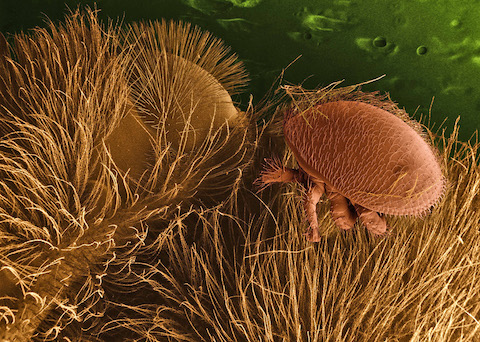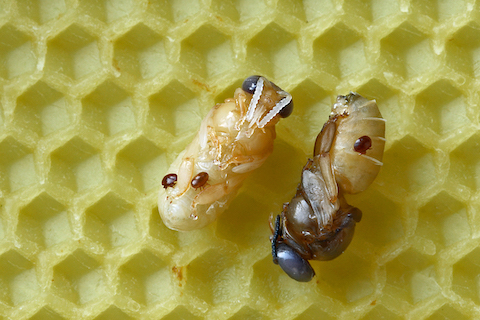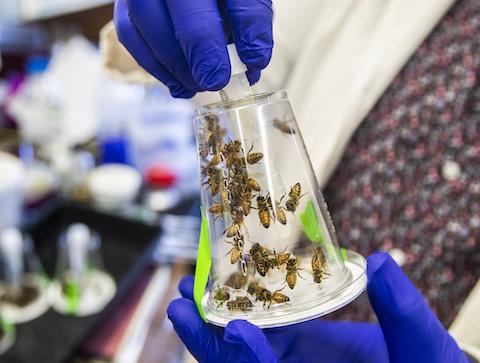
On another EarthDate you heard that bees are dying.
While it’s common for a hive to lose 15% of its bees each winter, rates since 2007 have sometimes hit 40%.
This has scientists concerned, and after a decade of research, they’ve traced the bees’ troubles to several factors.
First, stress. A decrease in wild acreage means fewer wild bees, so that more commercial bees are needed for pollination. This has the hives traveling farther and more frequently.
Rising temperatures also have an impact, making it harder for bees to maintain the constant temperature needed in the hive.
Second, pesticides. A recent study of honey samples found most of them were contaminated.
While the concentrations were too low to affect humans, they impacted the bees’ ability to navigate and find nectar.
Finally, pests. The Asian Varroa mite has infested some U.S. and European bee colonies.
They feed on larvae and bees, weakening their immunity systems and making them more susceptible to disease, like the viruses the mite carries—including one that renders bees flightless.
But there is some good news on the horizon. Scientists are working on new bacteria for the bees’ microbiome that would kill the Varroa mite.
And, since mites, disease, pesticides, and stress work synergistically, eliminating one or more of them may allow the colony to better manage the others.
Humans need to get on the bee team so bees can continue to pollinate our global food supply.
Background
Synopsis: In previous EarthDate episodes we talked about the social structure of honeybee colonies, the remarkable honey they produce, and our reliance on commercial beekeepers for the pollination of many of our food crops. However, there are threats to the health of honeybees that are now under investigation that could impact our access to certain foods. Recently, researchers have discovered a possible way to protect honeybees from one of these threats.
- Winter death tolls for commercial hives have recently increased from 15% to nearly 40% in 2019 due to what is believed to be a combination of stress, pesticide exposure, pests, and diseases.
- In the winter of 2006 to 2007, beekeepers reported large-scale losses of colonies, referring to the symptoms as Colony Collapse Disorder, or CCD. Adult bees would become frantic, leaving young bees, brood, and honey behind in the hives and not returning.
- Some breeders have had to replace as much as half of their bee livestock each year by splitting healthy colonies and adding new queens.
- These symptoms have continued to the present. Despite more than a decade of research, no single specific cause has been attributed to CCD—rather, it appears to be a syndrome driven by multiple combined causes that have recently been shown to operate synergistically.
- When bees sense they are dying, they fly away from the hive to ensure it is not contaminated. Without the warmth of the colony, they die, committing what is known as altruistic suicide.
- In Varroa-weakened hives, adult bees succumb more easily to disease or become disoriented by sublethal levels of pesticide. This may lead to them sensing they are contaminated and leaving en masse to save the hive, with only the brood and young bees remaining behind.
- A variety of factors increase stress on honeybee colonies.
- Honeybees must keep their hives at a temperature of about 93°F (34°C). They can regulate the hive temperature by beating their wings in the presence of water droplets. Increasing global temperatures are making this thermoregulation more difficult for bees to achieve, creating stress on colonies.
- The pollination of huge commercial farms with crops of just one type—a practice known as monoculture—limits the diversity of the nectar and pollen bees can collect, weakening hive immunity.
- As large-scale commercial farms edge out the prairie and forest habitats of wild bees, the wild bees depart, increasing reliance on commercial pollination services. These services require hives to be transported, causing transitional and temperature stress.
- Tree resin is a key ingredient of propolis, which has antimicrobial and antifungal properties, so honeybees also need access to trees to keeps the hive healthy. Monoculture and the removal of forest habitats limit bees’ access to the trees they need.
- In a recent study on 198 samples of honey sourced from around the globe, about 75% of the honey tested was found to be contaminated with neonicotinoid pesticides.
- Neonicotinoids (neonics) are the most widely used insecticides in the world. They are typically administered via seed coatings as a systemic preventative. Doing so renders the entire plant toxic but avoids dangerous spraying practices that may result in the pesticide drifting away from the intended field.
- Neonics attack the nervous system, and while the concentrations discovered in honey (around 1.8 ng/g) are below limits set by the European Union for safe human consumption, honeybees are much less tolerant.
- Older broader-spectrum pesticides are said to be more lethal to bees. However, it has been established that honeybees are especially sensitive to sublethal doses of neonics, which affect their learning and memory, making it difficult for them to locate nectar and pollen and navigate their way back to the hive. Other insects may be similarly sensitive.
- Farmers are very careful to prevent harm to the honeybees their crops depend upon, but even if honeybees are removed during pesticide/fungicide/herbicide treatment, they may still be exposed from nearby crops, soil, and water.
- There are thousands of combinations of pesticides, fungicides, and herbicides that may produce undocumented adverse effects in the bees that frequent treated fields.
- Honeybees are ravaged by one particular pest that has evolved to prey on them.
- Out of more than 16,000 species of bees, only 7 are major species of honeybees, and of those seven, humans preferred just one species—the European honeybee, Apis mellifera. This species is favored for being highly productive and docile.
- Asian bees, Apis cerana, evolved in the presence of Asian Varroa mites and they have developed defenses against the parasite. But when European honeybee hives were transported to Asia, the Asian Varroa mite jumped hosts to these defenseless visitors (and some of their cousins), evolving rapidly into the European honeybees’ principal parasite—the Varroa destructor mite.
- The mites specifically target honeybees and their larvae, multiplying by laying eggs in capped brood cells. It has become the only way the mites can reproduce.
- Varroa destructor mites feed by liquifying some of the bee or larvae’s internal fat body tissue and sucking it out. This tissue typically regulates the bee’s hormones and energy, provides an immune response to microbes, and helps to detoxify the bee after pesticide exposure.
- Mite-infested larvae hatch into smaller-sized young bees with weakened immune systems, making them more sensitive to pesticides and more prone to bacterial, fungal, and viral infections—particularly at the site of the feeding wound.
- Initially, mites attack only the drone larvae, synergistically keeping the hive alive. But when drone larvae run out, mites attack the workers and even the queen. Unfortunately, infested bees can even transport the mites to other hives.
- The mites first arrived in North America in about 1987. As of May 2019, though they are not believed to be found in Australia or Antarctica, they have reached all other continents.
- There is another Asian parasite, called the Tropilaelaps mite, that has not yet made its way to the United States. It is less specific to a particular genus or species of bee, so it is more of a threat to wild bee populations.

- Bacteria, fungi, and viruses can plague a hive weakened by pests.
- Varroa destructor mites are known to be a vector for at least five serious bee viruses, such as the deformed wing virus that renders bees flightless. This virus is very difficult for beekeepers to defend their hives against.
- Viruses transmitted by Varroa destructor mites appear to be mutating into more virulent types, creating new problems that have to be addressed each year.
- Additionally, a recent study showed a synergistic effect of the combination of pesticides and pests.
- Healthy bees exposed to neonicotinoids were not impacted in terms of body mass or lifetime longevity.
- But during a subsequent Varroa destructor infestation in the same hive, bees suffered from decreases in body mass in summer and fall, when bees live for only about 6 weeks.
- This loss of body mass compromises bees’ ability to survive past 16 weeks in the winter, causing the hives to fail in the winter season—the same symptom of CCD beekeepers have been seeing year after year.

- A recent discovery provides some hope: researchers at The University of Texas have used RNA interference to modify a bacterium that lives in the gut microbiome of honeybees. This bacterium is designed to trick mites and their viruses into dismantling some of their own DNA, which kills them.
- While humans have highly variable gut microbiomes that are home to thousands of gut bacteria, all honeybees have the same 6–8 gut microbes.
- When certain honeybees were fed the genetically engineered bacteria, their mites were 70% more likely to die.
- In another trial, bees fed the engineered bacteria were 36% more likely to survive a Varroa destructor mite infestation when compared with bees that had not been fed the bacteria.
- This customized treatment needs more testing, and the engineered bacterium needs to be evaluated before the method can be used in the wild. In the future, we may see other custom genetic approaches designed to help bees face other threats.
- Researchers continue to work diligently to save the honeybee populations that are so critical to our food supplies.

